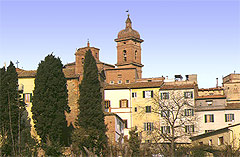 SINALUNGA
SINALUNGAUntil 1864 the town was known as Asinalunga (long donkey) as is almost certainly of Etruscan origin. Traditionally an agricultural centre, the town today also has some industry: brickworks, pottery, furniture manifacture, light engineering and glass. The comune includes the villages of Rigaiolo, Scrofiano, Bettolle, Farnetella, Guazzino, and Rigomagno. Its numerous remains and finds also make it attractive to tourists. In the oldest part of the town we can still see the line of the medieval walls, of which some towers still remain. In the collegiate church there is a "deposition" by Girolamo del Pacchia and paintings by Benvenuto di Giovanni and Sodoma. Famous people born here include Giuseppe Stocchi, great writer, historian and man of letters, the zoologist Ezio Marchi (1869-1908), the musician Ciro Pinsuti (1828-1888), pupil of Rossini, author of the novel "Il mercante di Venezia". In 1867, in palazzo Agnolucci, Giuseppe Garibaldi was arrested by the army to prevent him from marching on Rome.
TOP
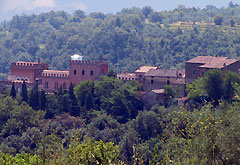
FARNETELLA
This name comes probably from "Farnia" tree, very similar to the oak. In old times it was a castle belonging to a branch of Caccia's family and before them to the nobel family of Baroti who on the year one thousand were the owners of castels in S.gimignanello, Torre sant'Alberto and Castiglion Baroti near Rapolano.
The village has still the ancient structure with parallel roads intersected by alleys leaving just a bit of room for the church and the castle (of last century).
Of the old walls it is left very little, just a piece of a defending tower among new buildings.
In the parish church of san Giovanni Battista beginning of 1392 (on an aisle),are kept frescos of "Madonna col bambino" (end of XV cent and beginning of XVI cent) "Madonna del rosario" (Sebastiano Folli' school XVI cent.), "Madonna in trono e santi"( first middle of XV CENT.)
TOP
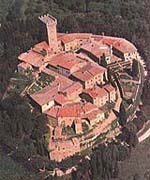
GARGONZA'S CASTLE
It is a very small but impressive village with stone houses encircled by remnants of old walls with the entrance door of the thirteen century. On the delightful small square at the feet of the castle's tower we find a Romanesque church with a bell tower with a mullioned window of the fourteenth century.
This typical stronghold (where also Dante was at the beginning of his exile) during the middle age was put here to guard the road from Siena to Arezzo.
Since this castle like the one of Civitella della Chiana, Cennina, Romena were a defensive structure during the wars between Guelphs and Ghibellines, and therefore it was contended for a long time by the people of Siena , Arezzo and Florence.
Built on the fourteenth century surrounded by high walls, in the middle of a wood highly situated, recently has known a new reality when on the sixties was well restored to make it comfortable to be lived in, keeping the original structure. So to the traditional rustic image was added a cultural turistic image.
The restoration of the castle has been regarde one of the best in Tuscany of a medieval village.
Inside the wall all green spots and the typical cobbled surface of the small square of the village have been converted in the original shape. Near there is a very simple small medieval church.
TOP
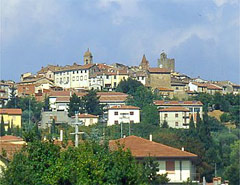
MONTE SAN SAVINO
Of Etruscan origin ,it keeps intact the renaissance structure. It was destroyed during the wars of Arezzo , it has been rebuilt later.Here was born Andrea Contucci nicknamed "Sansovino" who gives the village a particular feature.
His master pieces are: the"Loggia dei mercanti" with five arches of grey stone over columns and channelled pilaster stripes with Corinthian capitals.
Church of Santa Chiara of the seventeenth century, with interesting statues of the renaissance.
Church of S.Agostino of the first half of XIV made wider on the 500 maybe from Sansovino. The façade has smart gothic portal and a rose window; on the left side there is a cloister surrounde by a portico over columns and loggia, maybe drawn by Sansovino, but built on 1532.
Baptistry of S.Giovanni with a beautiful portal of Sansovino.
The town hall is work of Antonio da S.gallo il "vecchio" has a ashlar footing and classical windows; the back side of the building is work of Nanni di Baccio Bigio.
The tower of the "Palazzo Pretorio" built by Perugini on the XIV XI Century, is the only one left of the seventeen that were there to defend the town, 45mt high with stone coat of arms and battlements. "Rocca del Casser" is a Sienese githic building of the second half of 300.
From monte S.savino going to wards Siena on the express way 73, we arrive after 7 km to Gargonza'castle.
TOP

LUCIGNANO
It is on a hill, from where one can look at a wide view of Valdichiana 392 m. high with 3223 inhabitants, agricultural center of romanetruscan origin. It is ellittic plant is an interesting example of middle age style.
On the last two sunday of may there is the "Maggiolata" folkloristical festival we enter through S.giusto door and we go left on the Rosini road: on the left we find "il Cassero" (sec.XI) square tower from where one can look at a wide view all around. On the right through an open gallery we find the Collegiata (S.Michele), of 1594, built by Orazio Porta, it is very interesting for the classical architecture of that time and for other several works of art.
Inside an aisle with high dome has valuable altars in local stone . On the right of the entrance we find two wood, polycrome statues of Sienese school of 400 (Madonna col bambino)., on the right transept of the altar " S.Carlo di Borromeo crucified by a woman" work of Giacinto Gemignani. The high altar was made by Andrea Pozzo. On the left transept of the altar : visitazione and angels by MatteoR. In the aisle at the left of second altar "Martirio di S.lucia" of Gemignani.
Altars on the pillars and at the sides of the presbytery 8 angels in golden wood by Giosafat Zaneboni (1706). On the left : tribunale square with the fourteenth century, town hall with stone coat of arms.Inside yhe ancient "sala del tribunale" , and "cancelleria " preserves allegorical frescos of justice of the beginning of '400; on the "wedding hall" there is a fresco "Trionfi di Cesare " by Luigi Ademollo (1812).
TOP
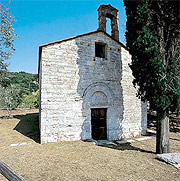
RAPOLANO TERME
It stands on the land of clay among woods, hills and of the river ombrone valley.
Here and there profile of ancient farm houses to test a peasant culture still alive.
Since Roman times was known for the "Terme" as we can see in the archaeological settlement of "Campo muri", under Frankish rule became, like S.gimignanello and Serre property of Cacciaconti Family.
Later on the thirteen century went under Siena 's dominion.
During this period started small land owners, who improved the economical position of this land.
The bond between Siena and this land became stronger at the end of thirteen century.
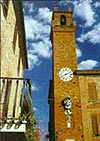 TORRITA DI SIENA
TORRITA DI SIENALocated in the centre of the Valdichiana, Torrita has transformed its traditional agricultural economy into on of light industry and crafts. The earliest historical records date back to 1037. The town subsequently became a fortress defending the Republic of Siena along its southern borders. Remains of the original walls include nine foundations and three doors. THe churches of S.Flora and S.Lucilla contain frescos and other valuable artistic works from the Sienese school. Here was born the famous highwayman Ghino di Tacco dei Monaceschi Pecorai and the Franciscan monk Iacopo da Torrita the restorer of mosaics. The donkey race "Palio dei Somari", takes place in March. Apart from the town itself, composed of the historical centre and a newer development, do not miss visiting Montefollonico, a village built around a former medieval castle and having remained largely intact. The walks here are particularly enjoable.
TOP
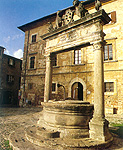 MONTEPULCIANO
MONTEPULCIANOMontepulciano is the largest Municipality in the Senese Valdichiana and contains six other villages: Abbadia di Montepulciano, Acquaviva, Gracciano, Montepulciano Stazione, S.Albino and Valiano. The poet Agnolo Ambrogini (known as "il Poliziano" from the Latin "mons Politianus") was born here. The town is said to have been founded by the Etruscan king Porsenna and exhibits impressive architecture, mainly but not only Renaissance. Michelozzo, Baldassarre Peruzzi and Vignola all worked here, as did Antonio da Sangallo il Vecchio who designed the temple of San Biagio. Apart from the wonders of the historical centre of Montepulciano the tourist would do well to visit the spa centre at S.Albino. The local economy is based on agriculture and the town is famous for its Vino Nobile. In th summer the town hosts the "Cantiere Internazionale d'arte" and in the mid-Augut holidays the "Bruscello", a traditional show spoken in rhyme, is performed on the Cathedral steps. On August 29 a wine barrel race, the "Bravìo", is run between the different contrade, or districts, of the town and there is a procession in 13th-century dress.
TOP
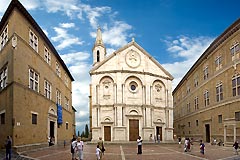
PIENZA
The history of Pienza coincides with that of its founder, Enea Silvio Piccolomini, later to become Pope Pio II. When his family, was forced out of Siena, took refuge in Corsignano, in the Val d'Orcia, wehre they owned a house and some land. Enea Silvio was born here in 1450 in a small fortified hamlet built around a Romanesque parish church. Traces have been found that this area was inhabited from the Neolithic to the Bronze age and this hamlet was also known in Roman times.
When he became Pope decided to transform his birthplace from a hamlet into a town. He wanted in this place famous architects and artists to create a big plan that was a city, that he renamed Pienza, and at the same time a monument to the Renaissance. He was insipred not so much from religious devotion, but from a dream transform the world through a modern way of thinking which was both tolerant and cosmopolitan. It is difficult to know what Pienza would have become if Pio II had not died suddenly on the eve of his crusade to fight the Muslism on 14th August 1464. However, after his death Pienza remained unchanged, perfectly balanced in its modern geometry.
The Piazza Pio II, laid out by Bernardo Rossellino, demonstrates an architectural and philosophical concept that represents the Humanist movement. In the square, the celebrated cathedral "domus vitrea", with a Renassaince facade and a Gothic interior, contains works by some of the finest artists from that period: Giovanni di Paolo, Matteo di Giovanni, il Vecchietta, Sano di Pietro; here you can see fine wooden choir stalls in Gothic style and other sacred works of great value.In the majestic Papal residence Palazzo Piccolomini, there is a museum, in the "sala d'armi" there is a display of arms, you can visit the Pope's Bedroom, the Library and the collection of medals of Pio II and Pio III.
The Muse Diocesano (in Palazzo Vescovile) contains beautiful Flemish tapestries from the XV-XVI century and works by Bartolo di Fredi, Vecchietta, Maestro dell'Osservanza, Sano di Pietro and Pellegrino di Marino.
In 1996 Pienza was recognised by UNESCO for its cultural value and inscribed on their World Heritage List.
TOP
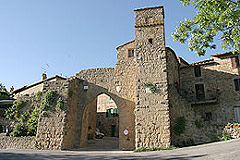
MONTICCHIELLO
Monticchiello os a pretty medieval village in the heart of the Val d'Orcia, which origins lose themselves in the time.The first official document dates back to the 973, when the marquis Lamberto Aldobrandesco surrendered the castle to the Badia Amiatina for a conspicuous sum of money. In the following years Monticchiello will belong to the Roman church and particularly to the Teutonici riders (until 1230), that being an order accustomed to fight, resulted proper to administer a territory of frontier.
The first document relating the free Commune of Monticchiello brings the date of the 1243. From this moment, for beyond three centuries, the castle remained faithful to Siena until his capitulation in 1559 with the Frank-Spanish war, becoming, like the whole state of Siena, part of the Granducato of Tuscany.
After five centuries the Commune of Monticchiello came under the jurisdiction of the Commune of Pienza in 1777.
Teatro Povero di Monticchiello
The poor Theater of Monticchiello, born in 1967, realizes a life and culture experience particularly interesting. The inhabitants of the place, in fact, from the end of July for almost all month long of August, put in scene a drama, in the main square of the village, with daily replicas, that is completely written, directed and staged by themselves; the same staff creates also the music and the scenery.
In the last years the performances, "recited" in the typical Val d'Orcia dialect; have been divided in two parts, the first concerning experiences of the past country life during the first half of the 20th century, the second dramatising themes of current events.
The theatrical experience of the people of Monticchiello from "popular experiment" has become a meaningful example of making theatre in Italy, with flattering judgments of public and review.
TOP
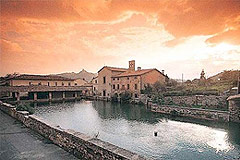
SAN QUIRICO D'ORCIA AND BAGNO VIGNONI
Originally an Etruscan town, it acquired importance thanks to the neighbouring Via Franchigena. Federico Barbarossa, in 1154, received the ambassador of Pope Adrian IV here and this event is recalled in the "Festa del Barbarossa", 3° Sunday of June. In 1167 it was seat of the Imperial Vicar. The Florence of Cosimo I de' Medici purchased it in 1559.
The Collegiata of SS. Quirico and Giuditta is in the Romanesque style: it has three portals and one whit faces southern is attributed toGiovanni Pisano. Inside is found the polyptych of Sano di Pietro and a Chorus from 1432-1502. Palazzo Chigi is from the XVII century. The "Horti Leonini"(16 th century) are one of the first examplesof of Italia Garden style: from August to October there is an exhibition of sculpture "Forms in green". The Romanesque parish church of S. Maria Assunta was, perhaps, constructed on the remains of a pre- Cristian temple. The inside of the church of S. Francesco holds two wooden polychrome statues and a Robbia's Madonna. The area of Bagno Vignoni was known about from roman times through the benefits of the waters from its spring which gush forth at temperatures of more 50°C. and are gathered in the big basin which lies at the centre of the town and gives it its evocative appearance. There is a small sanctuary dedicated to S. Caterina from Siena situated at the side of the basin. The castle of Vignoni looks down upon the town and can be roached either by S. Quirico or by Bagno Vignoni: a natural walk which can be made on foot.
TOP
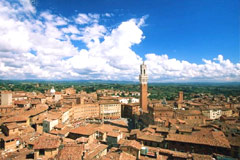
SIENA
Situated 322 m. above sea level in the heart of Tuscany, this town is built on three hills, maintaining intact its medieval appearance characterized by narrow winding streets and noble buildings.
Of Etruscan origin, it was a Roman colony with the name of Sena Julia; its importance grew in the Middle Ages, first as the seat of Lombard gastalds, and then of Counts under the Carolingian domination. After a long period of episcopal dominion (9th-11th century) the town reached a peak of power after becoming a municipality (1147), undertaking a policy of expansion towards the bordering territories.
Confrontation with Florence was inevitable and the struggle lasted, with various vicissitudes, until 1555, when after a long siege, Siena was conquered by the Florentines, losing its autonomy and becoming part of the Duchy, sharing its fortunes until unification with Italy.
Events: Palio of Contrade (2nd July and 16th August), St. Caterina's Celebration (29th April), Musical Weeks in Siena (September).
TOP
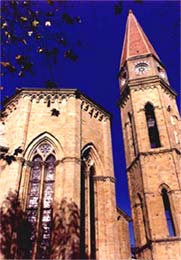
AREZZO
Arezzo Strategically located on a hill at the convergence of the Valdarno ,Casentino and the Valdichiana valleys, ancient Arezzo was one of the richest cities of the etruscan dodecapolis.Nor it has one of the biggest jewellery industries in Europe and its second most notable industry is forniture-making and marketing antiques. On the first weekend of each month the main square Piazza Grande becomes an enormous antique curiosity shop.Piazza Grande is also the perfect backdrop for the Giostra del Saracino, a celebration of the feats of arms against saracen pirates who menaced the tyrrhenian coast,and penetrated inland even as far as Arezzo .
You can find its typical Christian medieval architecture in the Pieve di S.Maria, with its beautiful rich facade of going back sculptures to the school of Antelami and with the representation to its inside of "La the Madonna and Santi" of Lorenzetti. A careful and laborious job of restoration has given splendor to "La Legend of the Croce", that are frescoes of Piero Della Francesca ,conserved to the inside of the Basilica of S.Francesco.
The Church of S.Domenico conserve a beautiful Crocifisso of the Cimabue.
TOP

CORTONA
One of the twelve cities of the Etruscan League-substantial fragments of its primitive cyclopean defences can still be seen, incorporated in the medieval walls. Apart from a few fine Renaissance palaces, the prevailing character of Cortona's architecture is medieval, conferring on the steep narrow streets a strong sense of atmosphere. The city is commandingly situated (altitude 600 metres) and there are magnificent panoramas to every point of the compass, embracing the whole of the Val di Chiana. Prominent among many art works of various periods in the Museo dell'Accademia Etrusca are the Etruscan Chandelier known as the "lamp of Cortona", one of the most celebrated bronzes of antiquity, and the "Polyhymnia Muse", an encaustic painting of the Roman era, of Remarkable beauty. The Museo Diocesano displays works by Luca Signorelli, distinguished Renaissance painter and native of Cortona, and a much-admired "Annunciation" by Beato Angelico. The most important medieval buildings are the churches of San Francesco and San Domenico and The Palazzo Casali, which has a renaissance facade. In these, and in the Renaissance churces of Santa Maria Nuova and San Niccolò, valuable works of art are preserved.
TOP
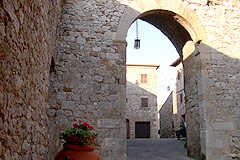
MONTEFOLLONICO
Montefollonico (576m above sea level) is a small medieval village whose raison d'être is found in the past rivalries between the republics of Siena and Florence; in fact the village was born as a Sienese fortress, against the "Florentine" Montepulciano. The first evidence of the area being inhabited dates as far back the Neanderthal man (approx. 60,000 years ago) with the Lithic tools found in the area of "Il Tondo" (now the public garden). In the following centuries we have accounts of a territorial dispute in the year 715 for the ownership of the church Pieve di San Valentino. The history of the village as such began in the XIIIth century with the foundation of the church Pieve di S. Leonardo by the Cistercian monks from the monastery nearby, who by dedicating themselves to fulling wool gave the village its name Mons a Fullonica. After various events Montefollonico was incorporated into the Tuscan Grand Duchy in 1555.
TOP
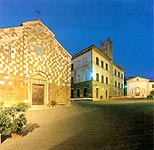
TREQUANDA
This former medieval hamlet, residence of the Cacciaconti family until the 1500s, stands on the top of a hill, deep in unspoilt countryside of woods, vineyards and olive groves. A third of the village is occupied by the Cacciaconti castle and its annexes including an impressive ornamental garden. Here you can visit the church of SS. Pietro and Andrea which contains a fresco by Sodoma. The mild climate, the relaxing countryside and the gastronomic attractions (wine, oil, cheese, salami, honey and local "chianina" beef) make the area a popular destination for agritourism. The town hall buildings in Petroio house the "terracotta association" and the terracotta museum is now being prepared. The pottery or "coccio", produced by the local manufactures is famous throughout Italy. Castelmuzio stands on a outcrop of tufa close to the monastery of S. Anna in Camprena which contains remarkable frescos by Sodoma; the parish church of S.Stefano is also nearby.
TOP
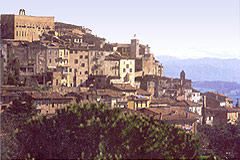
CHIANCIANO TERME
This spa town, which specialises in the treatment of liver disorders, is among the most famous in Italy. The special properties of the waters of Chianciano is not far from the spa centre with its hotels, shops, treatment centres and elegant parks where the therapeutic waters emerge: "acqua Sillene" is used for balnotherapy and mud-bath treatment; acqua Sant'Elena" used for the treatment of the kidneys and urinary disorders. Both the climate and the unspoilt green areas are excellentr, holidays here are fulfilling and pleasant and dedicated to health and fitness. More than 2 million people visit Chianciano every year. Cultural attractions include the Museo Etrusco, soon to be opened, and the Museo della Collegiata. Also to be seen are the collegiate church of S.Giovanni Battista, built in 1229 and restored in 1809, the church of the Compagnia (1517), the Torre dell'Orologio with Medici crest and the church of Madonna della Rosa (1585) designed by B. Lanci.
TOP

MONTALCINO
Without doubt, Montalcino lives a life of many souls.
Montalcino as the birthplace of Brunello wine, whic someone once defined as the best and most renowned wine in Italy. From the height of its 564 m. the ancient town dominates the surrounding countryside, clinging to the slopes of a hill crowned by the imposing 14th-century fortress.
In the labyrinth of little streets, amongst artisans'shops, small cafès and places selling typical local produce ( besides the wine, their honey and locally-made biscuits called "dead bones" are also well-known) the sights worth seeing are the fine Town Hall, the Bishp's Palace ( housing the United Civic, Diocesan and Archaeological Museums, with works by important 13th-16th century Sienese artists, such as Bartolo di Fredi, Il Sodoma, Bartolomeo Neroni), the antique Crucifix of Saint Antimus dating back to the mid-12th century, and the churches of Saint Augustine, Saint Giles and Saint Francis, all built between the 13th and 14th centuries, as well as the Sanctuary of our Lady of Succour. But it is just a little way out of town, near Castelnuovo dell'Abate in the Starcia valley that thhe heart of Montalcino spirituality is to be found:the Romanesque abbey of St.Antimus, a striking little temple enveloped in an almost magical atmosphere, founded by Charlemagne in 781. Finally, there are several castles on Montalcino land: the one worthy of mention is Poggio alle Mura, which has Longobard origins.
TOP
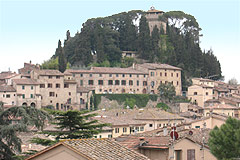
CETONA
On the eastern slopes of the mountain bearing the same name, Cetona has retained its medieval structure, whith roads, alleys and stairways all leading to the fortress which dominates it. The local economy is mainly agricultural, but tourism as also been actively developed. Many famous people from the words of economics, theatre, fashion and culture live here in their renovated country homes and villas. Whitin only 5 km of the town can be found one of the oldest settlements in central Italy, dating back 40.000 years, and today known as the Parco archeologico naturalistico di Belverde. There are 25 prehistoric caves and the largest of these Saint Francis prayed. The Museo Civico contains remains from the bronze age collected from the area around the caves. In the next village, piazze, the romanic Collegiate church contains frescos by Pinturicchio.
TOP
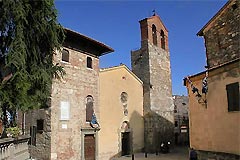
CHIUSI
In Etruscan times, on the southern edge of the Valdichiana, stood the town of Chamars, powerful enough, in that period, to defeat Rome. In the historical centre, with its medieval architecture as well as styles of the granduchy, remains of the Roman structure can still be seen which were built on top of yhe pre-existing etruscan town. The Museo archeologico nazionale contains excellent Etruscan finds and Greek ceramics from the contryside around Chiusi; the funeral urns and sarcophagi are particularly interesting. It is possible to visit the catacombs and Etruscan necropolises; the tomba del Leone (6th century b.C.) and the tomba della Pellegrina (5th century b.C.) are open. Definitely worth visiting are the Museo della Cattedrale and the "labirinto di Porsenna", underground water passages built by the Etruscan and including a large cistern which leads to the romanic cathedral bell tower. There are four neighbouring localities: Macciano, Montallese, Montevenere and Querce al Pino. Festivals: The festival of Santa Mustiola with its palio delle Torri and the September wine festival.
TOP
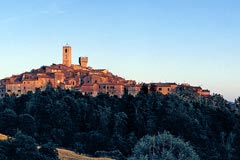
SAN CASCIANO DEI BAGNI
The main feature of this medieval town, which stands on the Sienese border between the regions of Umbria and Lazio, is its wealth of hot spring water, numbering as many as 42 springs. The waters here were already known in Roman times (Oratius alludes to their therapeutic qualities). The main economic activity is related to hot springwater tourism and to "agritourism" which thrives thanks to the unspoilt woods and countryside. Today, a new building stands next to the former spa centre where it is possible to have a variety of mud and water treatments. In the near vicinity the swimming pool is filled with hot spring water at 40°C. It is worth visiting the fairy-tale castle of Fighine. Traditional festivals include: the "Sagra dei Pici" - a homemade pasta speciality - in Celle sul Rigo, a village built on the site of a former fortress. The festival is held on the last Sunday in May. In San Casciano the "Sagra del Ciaffagnone" takes place on the first Sunday in June. The other frazione of Palazzone is wellknows for its wine festival and its strong Chianti Colli Senesi wine.
TOP